Ilmuwan Akhirnya Menjelaskan Bagaimana Piramida Dibangun
Summary
TLDRThe script delves into the construction and mysteries of the Great Pyramid of Giza, one of the Seven Wonders of the Ancient World. It discusses the history, architectural precision, and the labor force behind its creation, which involved over 25,000 workers. The video explores the technological and symbolic aspects of the pyramid’s design, from its alignment with the stars to its interior structure. It also touches on the Sphinx and its enigmatic features. Despite extensive research, many aspects of the pyramid's construction remain a mystery, highlighting the ancient Egyptians' incredible ingenuity.
Takeaways
- 😀 The Great Pyramid of Giza is one of the Seven Wonders of the Ancient World and the only one still standing today.
- 😀 There are more pyramids in Egypt besides the Great Pyramid, but Giza is the most famous and largest.
- 😀 Ancient Egyptians believed pharaohs were chosen by gods to act as intermediaries in the afterlife and be transformed into gods themselves.
- 😀 The pyramid complexes, including the Great Pyramid, were built to ensure pharaohs had everything they needed for the afterlife, including food, furniture, and gold vessels.
- 😀 The construction of the Great Pyramid involved over 2 million limestone blocks, each weighing around 2.5 tons.
- 😀 Contrary to popular belief, the workers who built the pyramids were not slaves but skilled laborers who came from all over Egypt, living in organized worker communities.
- 😀 The alignment of the pyramids was remarkably accurate, achieved by ancient Egyptians using star constellations and their knowledge of the sun’s movements, long before the invention of compasses.
- 😀 The Great Sphinx, with the body of a lion and the head of a pharaoh, is located near the second pyramid at Giza and is one of the largest and oldest statues in the world.
- 😀 The construction process involved moving and shaping massive stone blocks, with the limestone for the interior mined nearby and the outer limestone transported from a distance of 13 km.
- 😀 The methods used to transport and position the large stone blocks remain a mystery, with theories suggesting ramps or other ingenious systems.
- 😀 The interior of the Great Pyramid includes a series of chambers, one of which houses the sarcophagus of Pharaoh Khufu, but there are no hieroglyphs inside the pyramid itself, unlike the tombs of later pharaohs.
Q & A
What makes the Great Pyramid of Giza unique among the Seven Wonders of the Ancient World?
-The Great Pyramid of Giza is the only one of the Seven Wonders of the Ancient World still standing today.
Were the workers who built the pyramids slaves?
-No, the workers were not slaves. They came from all over Egypt to contribute to the pyramid construction, and they were well-fed, housed, and had more comfortable lives than the average person of that time.
How did the ancient Egyptians align the pyramids with such precision?
-The Egyptians used two star constellations to align the pyramids. They had no compass, but they were able to determine the cardinal directions with remarkable accuracy.
What was the purpose of the Great Pyramid of Giza?
-The Great Pyramid was built as a tomb for the Pharaoh Khufu, ensuring that the pharaoh would have everything needed for the afterlife, including food, furniture, and gold.
How many blocks of stone were used to build the Great Pyramid, and what was their weight?
-Over 2 million limestone blocks were used to build the Great Pyramid, each weighing approximately 2.5 tons, roughly the weight of a rhinoceros.
What was the most difficult part of the pyramid construction?
-The most challenging part was shaping the limestone blocks. Although the limestone was soft when freshly cut, it hardened in the air, making precision cutting crucial for the pyramid's stability.
What is the mystery surrounding the Sphinx of Giza?
-The Sphinx's nose is missing, and no one knows for sure what happened to it. Additionally, it is believed that the Sphinx was originally painted in bright colors, with traces of red, yellow, and blue found on its body.
How did the ancient Egyptians transport the massive limestone blocks for the pyramids?
-The blocks were transported using sledges. A mix of sand and water was used to make the surface slippery, allowing groups of 10 men to move the blocks easily.
What are some of the theories regarding the internal layout of the Great Pyramid?
-There are many theories about the internal layout of the pyramid. While archaeologists have found remnants of ramps used to move the stones, the exact details of the interior remain a mystery, with some suggesting there may be hidden chambers or tunnels.
What are some of the challenges scientists face in studying the interior of the pyramid today?
-Modern scientists use tools like small robots and X-ray technology to explore the pyramid's interior, but much of the layout remains unknown due to the complex, secretive design of the structure.
Outlines

Dieser Bereich ist nur für Premium-Benutzer verfügbar. Bitte führen Sie ein Upgrade durch, um auf diesen Abschnitt zuzugreifen.
Upgrade durchführenMindmap

Dieser Bereich ist nur für Premium-Benutzer verfügbar. Bitte führen Sie ein Upgrade durch, um auf diesen Abschnitt zuzugreifen.
Upgrade durchführenKeywords

Dieser Bereich ist nur für Premium-Benutzer verfügbar. Bitte führen Sie ein Upgrade durch, um auf diesen Abschnitt zuzugreifen.
Upgrade durchführenHighlights

Dieser Bereich ist nur für Premium-Benutzer verfügbar. Bitte führen Sie ein Upgrade durch, um auf diesen Abschnitt zuzugreifen.
Upgrade durchführenTranscripts

Dieser Bereich ist nur für Premium-Benutzer verfügbar. Bitte führen Sie ein Upgrade durch, um auf diesen Abschnitt zuzugreifen.
Upgrade durchführen5.0 / 5 (0 votes)






